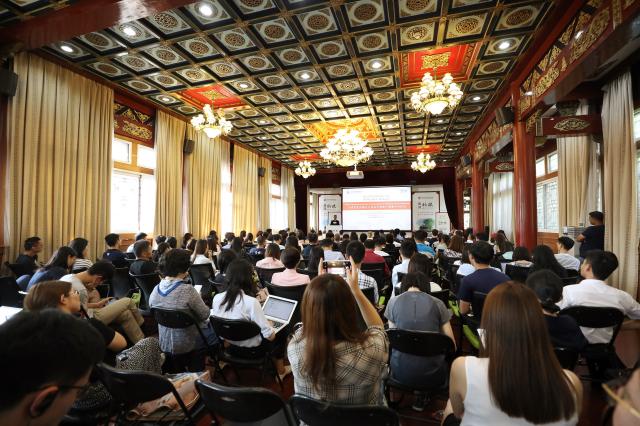
The International Monetary Fund (IMF) chief economist Prof. Gita Gopinath delivered great depth and breadth of the latest insights into the global trade issues and the role of exchange rates in facilitating external adjustment at the 139th NSD Policy Talk held at the Langrun Garden, the National School of Development at Peking University (NSD) on the afternoon of September 6, 2019. The lecture was hosted by Professor YAO Yang, Dean of NSD, and Professor HUANG Yiping, Deputy Dean of NSD, who gave his insightful comments on the issues discussed in the lecture.
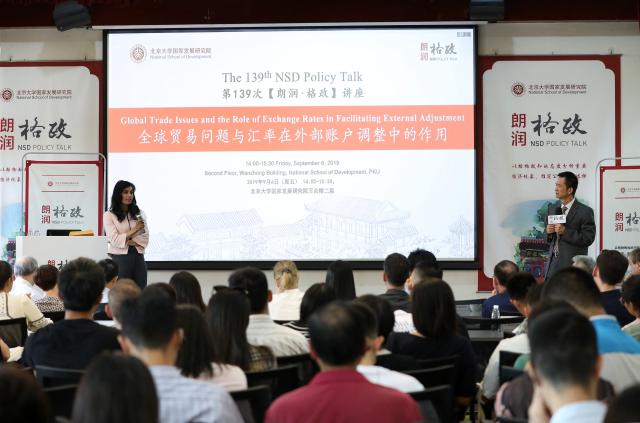

Prof. YAO Yang
According to Professor Yao's opening remark, Professor Gita Gopinath was born in India, received her PhD from Princeton University in 2001 and worked at the University of Chicago before moving to Harvard in 2005. She has performed extensive research on International Finance and Macroeconomics and published monographs and papers on top journalsand. She is the co-editor of the current Handbook of International Economics and was earlier the co-editor of the American Economic Review and managing editor of the Review of Economic Studies. She had also previously served as the co-director of the International Finance and Macroeconomics program at the National Bureau of Economic Research (NBER), which has historical links with NSD to some extent. As a NBER delegate, she attended the annual NBER-CCER Conference in 2009, which was her first visit to China.
Professor Gita Gopinath is an elected fellow of the American Academy of Arts and Sciences and of the Econometric Society, and recipient of the Distinguished Alumnus Award from the University of Washington. In 2009, Foreign Policy named her one of the Top Global Thinkers, in 2014, she was named one of the top 25 economists under 45 by the IMF and in 2011 she was chosen a Young Global Leader (YGL) by the World Economic Forum. In January 2019, she began to serve as the Chief Economist of the IMF.
Therefore, Gopinath's presentation was worth looking forward to.
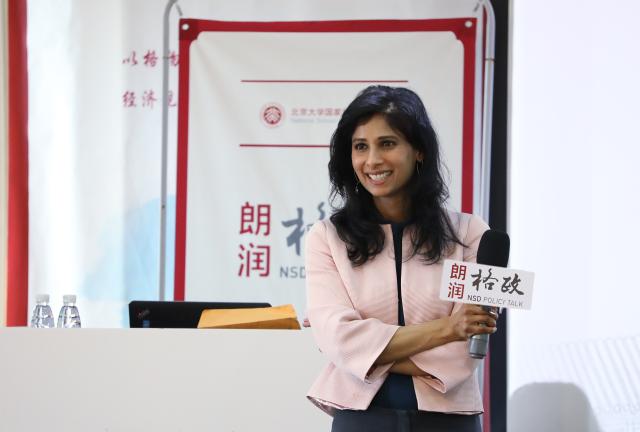
Professor Gopintath's presentation was comprised of two parts. She firstly analyzed trade issues and then moved on to exchange rates. In the current international context, trade tension, trade disputes and currency wars are emerging. So the two above-mentioned issues are closely related.
· Decline In Global Trade
Professor Gopintath pointed out that the global trade scenario may further worsen especially compared with the year 2016, and currently the world trade has slipped back into a negative growth. The statistics revealed the import in many countries had dropped and painted a gloomy picture of Eurozone, the US, China and emerging countries in Asia.
Two factors contributed to the global trade slowdown. One is trade tension and the other is the falling automotive industry. Vehicles represent a significant share of global merchandise trade and also play a big role in the global value chain. Recently tougher car emission standards have been implemented in Germany, and China is also trying to slash emissions for new cars. Besides, the end of the preferential policy on auto purchase also dragged the car industry into sharp slowdown.
In stark contrast to the sluggish manufacturing industry in many countries, the service industry witnessed rapid growth. One important reason was the policy uncertainty, because the turmoil in polices and geopolitical tension reduced the willingness of investors to inject further capital into the manufacturing industry.
· Influence of China-US Trade War
The trade volume between China and the US is declining, including China’s imports from the US and China’s exports to the US. In particular, the product categories that the US announced additional taxes saw steep plunge in import. On the other hand, highly globalized industries that depended more on foreign trade for a large share of their state’s economic output performed poorly on stock market, significantly lower than the market trend.
The China-US trade tension also leads to price distortion. Take the soybean price as an example. Before China imposed additional import tax on American soybeans, the export prices of American soybeans tended to follow the same fluctuations as those observed for Brazil’s. But the price for American exporters plunged after China announced additional tariffs. In December 2018, China and the US reached consensus during the G20 Summit in Argentina that China would restart buying American soybeans, driving up the sagging US soybean prices to the similar level of Brazil’s. However, due to the escalating China-US trade tension, price divergence between US and Brazil soybean export appeared again.
· Trade Tension leading to Trade Diversion
Does the drop in American imports of Chinese goods lead to replacing such imports with American-made products or buying more goods from other countries to fill the import gap? According to the tariff list of US$16 billion worth of Chinese goods released in 2018, from September to October in 2018, the import volume of such targeted goods increased. US shifted its purchases to Mexico instead of increasing the domestic production.
Actually, we can observe the trade diversion in most product categories targeted by new tariffs. Compared with 2018, China’s share of US imports saw a year-on-year decline in the first half of 2019 , but shares of the EU, Mexico and Japan jumped. This is trade diversion. The US only increased its domestic production of a small number of types of products.
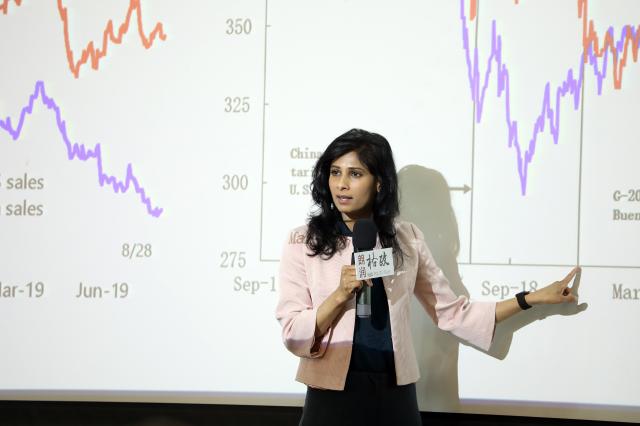
· Raised Tariff Can't Close Trade Deficit
The US trade balance in the first half of 2018 and 2019 suggested that imposing new tariffs would not produce much influence on trade volume, because apart from tariffs, many other factors would also affect the supply-and-demand relation in the market. The US goods trade deficit did not improve. Despite that US trade deficit with China dipped, the overall gap was still huge and the trade deficit with the EU increased. Generally speaking, the US has trade deficit with many countries and the overall trade deficit is enormous.
The World Economic Outlook report released by the IMF in April also pointed out that tariff hike would not reduce the bilateral trade deficit. If every country raises tariffs for the sake of self-protection, and theoretically, at some moment all the countries will have no trade deficit, which was an extreme scenario unlikely to happen.
· Who Bears the Cost of the Increased Tariffs?
Who pays for the costs of tariffs after the tariff hike? Generally speaking, exporters and importers will have to share the burden together. But as for the cases where the US imposed tariffs on China’s goods, US importers have to bear the brunt of tariffs imposed on imported goods.
The statistics showed that after the US imposed on US$34 billion, US$ 16 billion and US$ 200 billion worth of Chinese goods, US importers purchased the like products from other countries at similar prices. However, the prices of the commodities imported from China surged, and 80-90% of the increased tariffs cost would be passed on to US importers.
· Trade Friction's Impacts on Global Economic Growth
The IMF has measured the impacts of tariff increase on prices, trade volumes, and trade diversion, and analyzed the influence on global GDP. The result estimated a cumulative drag on GDP of 0.8% in 2020, which is the impact brought about by the tax increase over the 2018-2019 period on the world economy in 2020. Relatively speaking, China bears the brunt of the tariff hike with its GDP projected to fall by 2%, and the US economy is also expected to face a slowdown of roughly 0.6%. This is determined by multiple factors, such as China’s stronger economic externality, consumers’ confidence and the response to financial market.
The research shows that the trade friction will gradually lessen the impacts on China as time goes by. The reason is that after China survives the trade shock and Chinese producers and consumers are adapted to the new trade environment, the whole supply chain will accordingly change and the public’s confidence will be boosted.
Professor Gopinath held that the trade uncertainty posed the biggest risk to global economic growth. The PMI investment products declined and industrial products such as machine tools also trended downward, which produced far-reaching impacts on world economy and global trade. This once again demonstrated the influence caused by the decoupling of the world’s two largest economies on manufacturing industry and further intensified the diversion between manufacturing industries and service industries.
Currently the effects of the trade friction have already spread to hi-tech field. For example, lots of people are concerned about cyber security and a string of sanction measures has been implemented. Such disputes are likely to have negative impacts on the popularization and development of new science and technology. Take Huawei as an example. Huawei has contributed a lot to the development of hi-tech and is one of the top patent-holders in the US, with many patents being used by Chinese and American research institutions. Such application could better improve and promote new technology. Unfortunately, Huawei was added into the Entity List.
Professor Gopinath worried that trade protectionism could result in a more fragmented global economy and looking deeper, fragmented technology also had negative impacts on improving production efficiency.
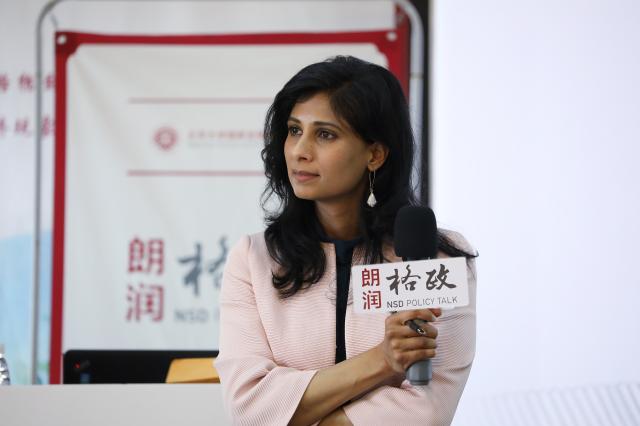
· Exchange Rates' Impacts on Trade Volume
On average, a 10% increase in taxes has caused a significant drop in US imports from China. Some held that exchange rate adjustments, such as a 10% depreciation of US dollars, would have the same effects. However, the quantitative analysis conducted by the IMF told a different story.
In the short run, if a currency depreciates by 10%, the imports will fall dramatically and it will be difficult to expand the imports in the short term. However, based on the analysis keeping an eye on over next 3 years, it can be seen that imports will gradually climb and export will become more sensitive. A 10% depreciation of the currency will show an improvement of 0.3% in trade balance, while tariffs have a much greater impact on trade volume.
Why are the effects of exchange rate changes on trade volume so limited and slow? Many people argue that if a country’s currency depreciates by 10%, the price of the country’s products sold abroad will also fall by 10%. Cheaper products are usually more competitive, and the sales volumes will also increase. However, this is not the case. Commodities tend to be priced in US dollars in bilateral trade, especially doing business in emerging countries, even though the trade partner is from other countries instead of the US. The imported raw materials and exported products of a company located in an emerging country are priced in US dollars. Meanwhile, if US dollars dominate the country’s foreign trade and the value of the local currency declines (dollar rises), the price of commodities measured in other currencies will also rise, which means the cost of imported goods will go up. Therefore, businessmen are not willing to lower the price of export commodities. The assumption that a 10% depreciation of local currency will lower the export prices of the commodities by 10% is not feasible.
· Deep Integration of Global Value Chains and the Relationship between Trade and Exchange Rate Sensitivity
As traditionally conceived, international trade is that country A sells products to country B, but the actual situation is much more complicated. Country A sells products to country B, but country A first need to import raw materials from country C and country B sells the deep-processed products to country D. The whole process is a very complex and deeply intertwined global value chain network that is not unilaterally affected by exchange rates. This means that a country’s trade balance will not generate too much influence on exchange rate flexibility. The exporters also act as importers, because they have to import raw materials to produce exported commodities. Consequently, the cost of exported goods are also linked to other currencies and exporters’ production has been part of the global value chain.
The analysis indicated that against the backdrop of the global value chain being deeply integrated, a country’s deeper integration into the global value chain will reduce the its trade balance sensitivity to exchange rates.
At the same time, we should see that on the one hand, the deep integration of global value chains reduces the sensitivity of trade to exchange rates; on the other hand, because the country is more open to international trade, the trade volume in 2019 is much higher than that in previous years and the trade will be more sensitive to the changes of exchange rates. These two factors offset each other. So overall, trade changes will not be so obvious.
· Changes in RMB Exchange Rate in Line with the Medium-Term Fundamentals
China’s current account takes up a large proportion of GDP, but now the share is decreasing. At the same time, a sharp appreciation of Chinese yuan (RMB) appeared from 2007 to 2015. China rebalanced its economy to increase domestic consumption and reduce its dependence on exports, which was the main reason for RMB appreciation.
In terms of RMB depreciation that has drawn global attention, Professor Gopinath said one of IMF’s missions is to evaluate the formation mechanism of global exchange rate. According to its assessment, China’s external account in 2018, including exchange rates and current account, is in line with the medium-term fundamentals and suitable for the current policies, which means China’s policy is advisable. The dynamic balance of its external account also reflects the changes in Chinese economic structure. The balance of China’s current account is declining. China is running a current account deficit from service sectors and from a trade perspective, the current account balance is positive.
· Policy Recommendations for China
Finally, Professor Gopinath pointed out that concerns about global trade tensions are justified. At this moment, adjustments in national policies and further modernization of the global trading system are needed. She called on all countries, including China, to discuss and improve global trade mechanisms and establish a transparent global trading system.
She put forward two specific suggestions for China: Firstly, gradually narrow the policy gap between the fiscal and credit sectors (referring to loose fiscal policy, excessive credit growth, and inadequate health spending). Secondly, adjust economic structures through reforms to ensure economic sustainable development, boost consumption and reduce overall savings rate. For example, reform social security network; deepen the reform of state-owned enterprises and further open up its market to introduce more competition; establish a more market-oriented and stronger financial system; take measures to attract more foreign direct investment and ensure that domestic and foreign investors could be treated equally; adopt a more flexible and market-oriented exchange rate system and a more market-oriented monetary policy system.
· Professor Huang Yiping’s Comment
After the speech, Huang Yiping, Deputy Dean of NSD and Member of the External Advisory Group on Surveillance of the International Monetary Fund spoke highly of Professor Gopinath’s presentation. He said this was a broad and comprehensive speech and she provided valuable suggestions for China’s structural reform. He also expressed his gratitude towards IMF's long-time support for China's structural reforms and its contribution to China.
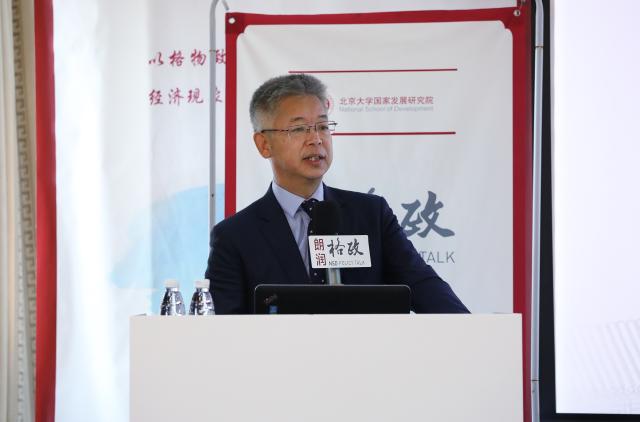
Prof. HUANG Yiping
Professor Huang shared his views on the issue of China's exchange rate. He said that since 2005 China has stuck to its managed floating exchange rate framework based on RMB value against a basket of currencies. The People's Bank of China (PBOC) set three objectives for foreign exchange policy: first, expand the flexibility of RMB exchange rate; second, make a steady transition to the phase where the RMB exchange rate's movement will be driven and determined by the market; third, maintain the relative stability of the exchange rate at a balanced and reasonable level, and try to reduce excessive volatility in a short term. The logic behind the three goals is to give play to role of market in determining exchange rates, but meanwhile avoid excessive volatility in a short term. Detailed data has revealed that from the beginning of 2017, the PBOC has not directly intervened in the foreign exchange market. The management of the exchange rate does exist, but the purpose of management is to avoid further depreciation of RMB, rather than spurring depreciation. Perhaps the US should call China “a country not manipulating exchange rate” instead of a“currency manipulator.”
Professor Huang said that a few months ago, an official from an international organization predicted that if Trump upgraded the trade war, the move would depreciate RMB. Then the US would say that China manipulated its exchange rate. What happened later verified the official's prediction.
Professor Huang once again stressed that the PBOC did not intervene in the foreign exchange market. Although the relevant management exists, the purpose of such management is to avoid further depreciation of RMB, rather than manipulating the depreciation. Recent exchange rate fluctuations indicated that the volatility of RMB is very close to the level of other major international currencies such as the Euro and the Japanese yen, which showed China's progress in this regard. The PBOC is also planning to allow the currency to freely float. However, if the fluctuations are so much that it is likely to threaten financial stability, some intervention measures will be implemented.
In the final Q & A session, Professor Huang Yiping, Professor Yu Miaojie and Professor Wu Xiaoying, and other attendees came up with questions on the capital account openness in developing countries, the analysis and calculation of some data mentioned in her speech, the global value chain, and the global economic trend. Professor Gopinath gave detailed answers to all of these questions.
